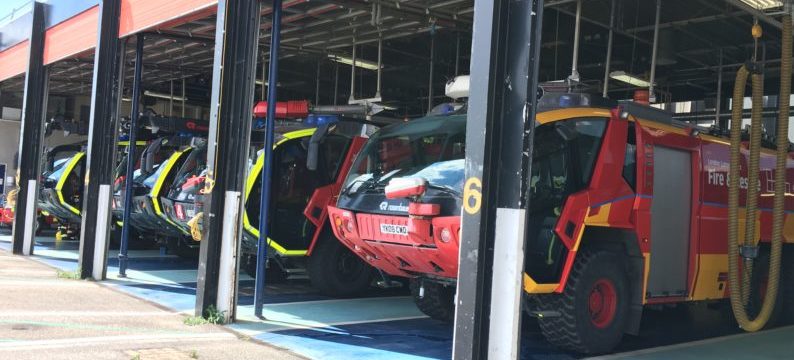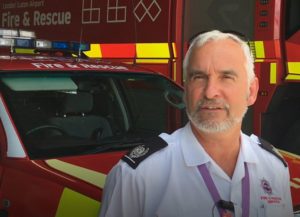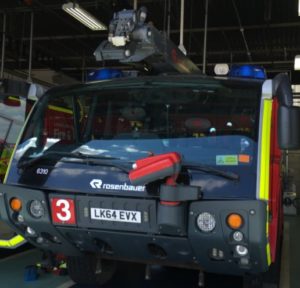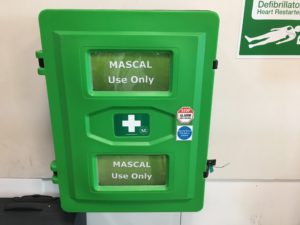SHP caught up with Luton Airport Fire Station Manager Paul Allen to find how passengers are kept safe and how the firefighting team play a huge role in keeping all staff at the airport compliant.

Luton Airport sees 16 million passengers pass through its terminal building every year and is currently going through a huge redevelopment. At its busiest, between 04:30 and 10:30, the airport can have as many as nine or ten aircraft lined up on its Alpha taxiway. Whist the fire station is in place predominantly too look after those incoming and outgoing aircraft, Paul Allen and his team also handle serious medical emergencies on the complex and are responsible for much of the safety training undertaken by the staff.
Each airport is given a fire category, which determines the type of aircraft the station has the capability to deal with. It also specifies how many crew are required to be on each ‘watch’ to enable enough manpower to sufficiently deal with an emergency involving various sizes of aircraft, this is determined by a Task and Resource Analysis (TRA). Luton is fire category 7, meaning it can safely handle aircraft up to 49 meters in length along a fuselage width of 5 metres.
The station consists of four watches, red, white, green and blue, and being a category seven airport requires at least seven crew to be on duty at a time. Though there is always one extra, to deal with any medical emergencies which may arise. At Luton, each watch has 12 crew, including three officers, with eight on duty at any one time. The watches work two days and two nights and then have four days off.
The station is responsible for any emergency on the site, from dealing with aircraft, small building fires and medical emergencies. They need to be able to respond to any incident within two to three minutes from the time of call. A crash alarm system is in place on the site, which can be activated from the fire station watch tower, or by air traffic control who may be in communication with a pilot who is coming into land with an issue.
Unlike traditional fire stations, where incident reports are printed and picked up in a control room prior to departure, all of the details are given to the crew over a PA system after the initial alarm has sounded. This means the team can get to the appliances and into their kit, whilst taking on board the information they need. This helps to minimise the response time. Some larger airports are even equipped with two fire stations, in order to be able to maintain that response time to all areas of the site.
Hierarchy

Paul Allen
Working under Paul is a Station Manager, whose job it is to liaise with local emergency services. He has his own incident command vehicle, allowing him to hold back and co-ordinate the response.
Being able to call upon Bedfordshire Fire and Rescue Service is a huge positive for the airport, according to Paul. Beds Fire has an average response time to the airport of eight minutes, some airports in the UK can wait up to 25-30 minutes for local authorities to attend. An eight-minute response time allows Paul his team to deal with any external fire, up to the point of making entry to an aircraft to achieve a survivable atmosphere inside. By that time, the added resources and manpower of the local fire service should be in attendance to provide support.
Then there is a Watch Manager, responsible for reporting to the Station Manager and also making sure the team is up to date with its competency training.
Then we have the Crew Manager whose role is to support the Watch Manager with the training and give a level of supervision at incidents.
Unsurprisingly, training plays a huge role in the day-to-day activities of an airport firefighter. The crew need to be fully up to speed on the intricacies and potential hazards of all the aircraft which use the airport, including a host of smaller private jets.
Fire behaviour
Paul and his team are fortunate to have a fire training ground on site, complete with a Boeing 767 simulator. They also have access to a gas fire simulator, allowing training for undercarriage fires, engine fires, internal fires, external fires, along with the facility to smoke the plane out, essentially any scenario that may occur in the real world.
A really useful facility that the crew train in two to three times a month, according to Paul. The site also enables the crew to train on breathing apparatus and learn about fire behaviour. Paul described it as “like putting the crew into a purpose built shipping container where the equivalent of a kitchen fire has been built. The guys enter the chamber and can learn how to recognise the signs and symptoms of a fire, such flash-overs and back-drafts.
“By firing a pulse of water at the ceiling, the team can ascertain how hot the fire is. They can listen and if they hear nothing hit the ground, they know the water has already turned to steam and so it’s a particularly hot fire.
“It’s about teaching them to use a minimum amount of water to monitor and change the conditions of the fire, for instance you can get tongues of fire in the neutral plain (smoke) which come up behind the guys or the fire kit can start to blister or show signs of pyrolization, giving off sufficient vapours to ignite. All of these are build-up signs that something particularly nasty is about to happen. It’s a brilliant piece of training.” Each watch trains on that site twice a year with theoretical training in between.
Such is the quality of the facility, Paul is able to sell training to Beds fire. This has two benefits, the obvious revenue it generates, but it also means that the crew trains with their local authority colleagues which, in the event of a major incident, means all the firefighters know each other, are used to working together and are used to each other’s working practices, allowing for a smoother operation.
“Airport fire services used to be seen as a necessary evil.” In Paul’s time at the airport, he can count on one hand the number of larger incidents he has dealt with, from a light aircraft missing the runway in the fog and flipping, another which got caught in a crosswind, nearly hit the fire station watch tower, and crashed into a stationary aircraft, a couple of small helicopter crashes and a couple of larger aircraft that came of the runway into the mud. “You’re always training for something which you hope will never happen and you could quite happily go into retirement without having witnessed a major air crash”.
Types of calls
With major incidents and aircraft fires thankfully few and far between, I was keen to find out from Paul what the most common incidents he is faced with. “We get aircraft in which have been diverted because they are low on fuel, so that’s something we have to be on standby for. Then there are undercarriage issues, which could be something as simple as a bulb failure on the aircraft dashboard, meaning the pilot is being shown that the undercarriage has not deployed correctly.
“Aircraft with an overheated undercarriage is another common call. This is where all of the energy from the flight has been transferred into the undercarriage and braking systems, which can start smoking if they are not cooled quickly or correctly.”
Equipment
 Some pretty hi-tech equipment is on hand to both aid and maintain the safety of the crew. The fleet consists of four Rosenbauer Panther fire appliances and a mobile command vehicle. Two of the Panther’s are fitted with high reach extendable turrets or HRET’s on the top (pictured, right).
Some pretty hi-tech equipment is on hand to both aid and maintain the safety of the crew. The fleet consists of four Rosenbauer Panther fire appliances and a mobile command vehicle. Two of the Panther’s are fitted with high reach extendable turrets or HRET’s on the top (pictured, right).
Paul explained that this technology helps to maintain the safety of his crew, restricting them from having to walk in the highly dangerous area beneath an aircraft, where they could be subjected to pressurised fuels, or the dangers of being pulled into an engine. Instead, a hydraulic arm with a camera can be sent in to assess the situation. The appliances are also fitted with underbody spray systems, enabling them to put out any burning fuel that may flow under the vehicle, while they are attending an incident.
Training
With a substantial amount of downtime, Paul looks for other ways to keep his team busy, compliant and to generate income for the station. With that in mind, he runs training courses from the station, using some of the specialist skills of some of his team. Some of the courses on offer to airport staff include Compartment Fire Behaviour (CFBT) training, first aid, defibrillator training, manual handling and airline training (all pilots and cabin crew have to have a ticket to fly and so are certificated every three years).
Aside from that, the team are highly trained in medical emergencies, which they also run a course on, described by Paul as ‘a feather in our hat’. It means they can dispatch to the most serious cases on site and be with a patient quicker than an ambulance can get to them. “The guys are trained to just below the level of paramedics and can respond to any serious medical incident in the terminal building, from heart attacks to seizures or major blood loss.”
Because of the stressful nature of flying, heart attacks are quite common at airports Paul told me. In fact, he explained that before I’d arrived that morning, his team had already attended a heart attack victim and sent them off to hospital in an air ambulance. “I’m in awe of everything they do. It can make you really proud seeing the amazing work they undertake, before coming back to the station and getting straight back on with their day job.”
Due to the work Paul and his team have carried out, defibrillators are now installed all over the airport complex and virtually every member of staff on site are trained how to use them. This means that before the fire crew has arrived on the scene, the patient can have a defibrillator fitted and will be safely cordoned off behind a privacy screen, all vastly increasing the chances of survival.
 The small downside to this, although it’s not a common occurrence, is that if a crewmember is ‘committed’ and dealing with a medical emergency on site, the fire category of the airport may have to be temporarily lowered to a category six, as they do not have the full complement of crew to attend to a category seven aircraft. That means, during that time, category seven aircraft are only allowed to land at the pilot’s discretion, because of the shortage of manpower to deal with any potential incident.
The small downside to this, although it’s not a common occurrence, is that if a crewmember is ‘committed’ and dealing with a medical emergency on site, the fire category of the airport may have to be temporarily lowered to a category six, as they do not have the full complement of crew to attend to a category seven aircraft. That means, during that time, category seven aircraft are only allowed to land at the pilot’s discretion, because of the shortage of manpower to deal with any potential incident.
The latest course in the portfolio is MASCAL or Mass-Casualty training, something that is unique Luton Airport. You can read about that in more detail, here. Launched following the Brussels Airport bomb in 2016, it is helping to prepare all staff on site with how to deal with a potential terror attack.
The training gives the firefighters a chance to bump up their salaries and keep their compliance up and the added income is an enormous help to Paul when it comes to running the station.
Fire Safety in 2023 eBook
SHP's sister site, IFSEC Insider has released its annual Fire Safety Report for 2023, keeping you up to date with the biggest news and prosecution stories from around the industry.
Chapters include important updates such as the Fire Safety (England) Regulations 2022 and an overview of the new British Standard for the digital management of fire safety information.
Plus, explore the growing risks of lithium-ion battery fires and hear from experts in disability evacuation and social housing.



 Some pretty hi-tech equipment is on hand to both aid and maintain the safety of the crew. The fleet consists of four Rosenbauer Panther fire appliances and a mobile command vehicle. Two of the Panther’s are fitted with high reach extendable turrets or HRET’s on the top (pictured, right).
Some pretty hi-tech equipment is on hand to both aid and maintain the safety of the crew. The fleet consists of four Rosenbauer Panther fire appliances and a mobile command vehicle. Two of the Panther’s are fitted with high reach extendable turrets or HRET’s on the top (pictured, right).
